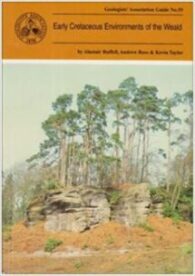Geologists’ Association Guide No 55
By Alistair Ruffell, Andrew Ross and Kevin Taylor

This is an interesting guide for someone like me who lives in the Southeast of England. In fact, I have commuted from London to Brighton by train, which took me through a cross-section of the Weald, which is the subject matter of this guide.
The GA decided that, so Early Cretaceous Environments of the Weald does not become out-of-date it concentrates on exposures that are likely to remain in their present state for some time. And given the amount of development that has occurred during the last few decades, this is no doubt sensible, as quarries and clay pits are gobbled up by housing estates.
It is intended that interested geologists will find the locations easily, observe the main features with no trouble, and be able to do this for some years to come. As always for GA guides, it first covers the general geology and geomorphology of the area, before setting out 11 itineraries. In particular, the guide covers the evolution of the Weald Basin, its stratigraphy and palaeoenvironments, and the nature of the locations.
These locations/itineraries consist of:
- The Hastings Group in the core of the Weald.
- Coastal sections around Hastings.
- The Weald Clay.
- Folkestone.
- The South Downs.
- The Weald Anticline around Petersfield.
- Haslemere to Godalming.
- The Hog’s Back.
- Albury.
- Redhill, Bletchingley and Godstone.
- The eastern North Downs.
The diagrams and photographs are not surprisingly black and white, but this isn’t a problem. They are still useful. So, for a guide that has a slightly more urban feel to it than most of the GA guides from the last century, this is well worth a try.
Early Cretaceous Environments of the Weald, Guide No 55, by Alistair Ruffell, Andrew Ross and Kevin Taylor, The Geologists’ Association, London (1996), 81 pages (paperback), ISBN: 0900717882


